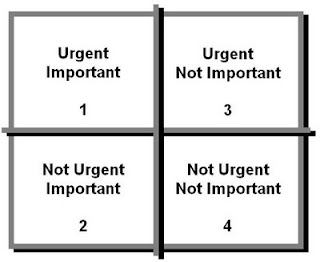
They might be simpler than important tasks, such as replying to emails or filling out forms, but we feel pressured to do these tasks first because they require us to be reactive. These two terms are sometimes used synonymously, but the matrix suggests that they should be treated differently. The Eisenhower Matrix has two key elements that are sometimes missing from other time management tools.įirstly, it requires you to distinguish between what is urgent and what is important. Inspired by Miller, Eisenhower claimed that to be successful, one had to do things that were both urgent and important: thus, the Eisenhower Matrix was born. Roscoe Miller, the 12th president of Northwestern University, who said, “The urgent are not important, and the important are never urgent.” 4Įisenhower understood that time management needed to both be effective and efficient and he wanted to help individuals navigate their priorities. After his terms as President, Eisenhower delivered a speech to the Second Assembly of the World Council of Churches, a fellowship of churches. He was incredibly accomplished and was able to manage his different roles with tact, grace, and efficiency. He retired from the military after 37 years of service to represent the Republican party, with Richard Nixon as his Vice President.Įisenhower was a very busy man with a multitude of responsibilities. 3 This ability got the attention of both the Democratic and Republican parties who wanted Eisenhower to represent them. He continued to increase in ranks over the years as a result of his impressive knowledge, effective organization, and social skills that enabled him to get along with others and mediate relationships.

3 Eisenhower was recognized by the Army Chief for his role in planning military exercises with almost 50,000 troops. He also served in France, Washington, the Philippines, and World War II. He served during World War I and later wrote a guidebook of its battlefields. Before being elected as President, Eisenhower had an impressive career in the military.

Eisenhower, who served in office from 1953 to 1961. The Eisenhower Matrix is named after the 34th President of the United States, Dwight D. Lastly, activities in the not urgent and not important category should be deleted altogether. Activities in the urgent & not important section should be delegated to someone else.

Activities that are not urgent & important should be scheduled for a later date – but you must ensure to stick to that schedule and not put them off. 2 Depending on which category your activities fall into, there are strategies for how best to deal with each one.Īctivities in the urgent & important category should be done immediately. The columns are labelled ‘urgent’ and ‘not urgent’, and the rows are labelled ‘important’ and ‘not important’. The Eisenhower Matrix is a four-category tool, with two columns and two rows. However, tools like the Eisenhower Matrix can help us overcome these biases by rationally categorizing our tasks by urgency and importance. With all these various biases leading us astray, it is no surprise that we find it difficult to know what to prioritize. The restraint bias causes us to overestimate the level of control we have over our impulse behaviors and underestimate how distracted we might get while trying to complete our to-do list. Bikeshedding describes our tendency to spend too much time on menial tasks because it is easier to have an opinion on simpler matters than to try and tackle the complex ones. Similarly, the optimism bias leads us to believe we are going to be more efficient than we are, so we might take on a task that is too big for us to handle alone. The projection bias causes us to take on big tasks when we feel optimistic, inaccurately projecting that we will continue to feel that way in the future.

There are a number of cognitive biases that impede our ability to manage our time effectively and efficiently.


 0 kommentar(er)
0 kommentar(er)
